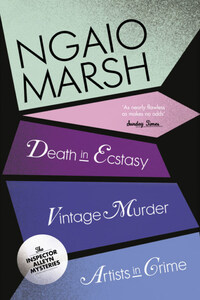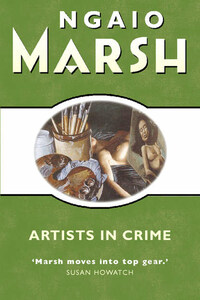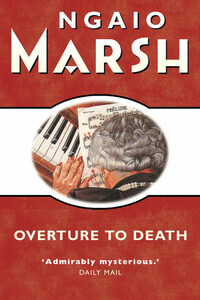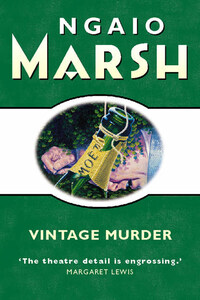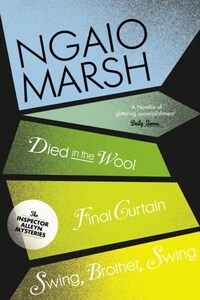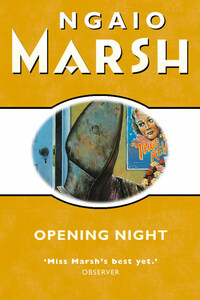HarperCollinsPublishers Ltd. 1 London Bridge Street London SE1 9GF
www.harpercollins.co.uk
Death in Ecstasy first published in Great Britain by Geoffrey Bles 1936 Vintage Murder first published in Great Britain by Geoffrey Bles 1937 Artists in Crime first published in Great Britain by Geoffrey Bles 1938 Portrait of Troy and Death on the Air first published in Great Britain in Death on the Air and Other Stories by HarperCollinsPublishers 1995
Ngaio Marsh asserts the moral right to be identified as the author of these works
A catalogue record for this book is available from the British Library
Copyright © Ngaio Marsh Ltd 1936, 1937, 1938
Cover design © crushed.co.uk
Portrait of Troy and Death on the Air copyright © Ngaio Marsh (Jersey) Ltd 1989
A catalogue copy of this book is available from the British Library.
All rights reserved under International and Pan-American Copyright Conventions. By payment of the required fees, you have been granted the nonexclusive, nontransferable right to access and read the text of this ebook on-screen. No part of this text may be reproduced, transmitted, downloaded, decompiled, reverse engineered, or stored in or introduced into any information storage and retrieval system, in any form or by any means whether electronic or mechanical, now known or hereinafter invented, without the express written permission of HarperCollins ebooks
HarperCollinsPublishers has made every reasonable effort to ensure that any picture content and written content in this ebook has been included or removed in accordance with the contractual and technological constraints in operation at the time of publication
Source ISBN 9780007328697
Ebook Edition © JULY 2013 ISBN: 9780007531363
Version: 2018-11-27
Troy made her entrance with the sixth of the books about Alleyn. In those days, I still painted quite a lot and quite seriously, and was inclined to look upon everything I saw in terms of possible subject matter.
On a voyage out to New Zealand from England, we called at Suva. The day was overcast, still and sultry. The kind of day when sounds have an uncanny clarity, and colour an added sharpness and intensity. The wharf at Suva, as seen from the boat-deck of the Niagara, was remarkable in these respects: the acid green of a bale of bananas packed in their own leaves; the tall Fijian with a mop of hair dyed screaming magenta, this colour repeated in the sari of an Indian woman; the slap of bare feet on wet boards and the deep voices that sounded as if they were projected through pipes. All these elements made their impressions, and I felt a great itch for a paint brush between my fingers.
The ship drew away, the wharf receded, and I was left with an unattempted, non-existent picture that is as vivid today as it was then.
I don’t think it is overdoing it to say that when I began Artists in Crime, it was this feeling of unfulfilment that led me to put another painter on another boat deck making a sketch of the wharf at Suva and that she made a much better job of it than I ever would have done.
This was Troy. It was in this setting that she and Alleyn first met.
I have always tried to keep the settings of my books as far as possible within the confines of my own experience. Having found Troy and decided that Alleyn was to find her, too, the rest of the book developed in the milieu of a painters’ community. It was written before capital punishment was abolished in Great Britain, and Troy shared my own repugnance for that terrible practice: I had talked with a detective-inspector and learnt that there were more men in the force who were for abolition than was commonly supposed. I knew Alleyn would be one of them. He would sense that the shadow of the death penalty lay between himself and Troy. It was not until the end of the next book, Death in a White Tie, that they came finally together. In Death and the Dancing Footman, they are already married.
My London agent, I remember, was a bit dubious about marrying Alleyn off. There is a school of thought that considers love interest, where the investigating character is involved, should be kept off stage in detective fiction or at least handled in a rather gingerly fashion and got rid of with alacrity. Conan Doyle seems to have taken this view.
‘To Sherlock Holmes she is always the woman’, he begins, writing of Irene Adler. But after a couple of sentences expressive of romantic attachment, he knocks that idea sideways by stating that, as far as Holmes was concerned, all emotions (sexual attraction in particular) were ‘abhorrent to his cold, precise, but admirably balanced mind’.
So much for Miss Adler.
An exception to the negative attitude appears in Bentley’s classic Trent’s Last Case, where the devotion of Trent for one of the suspects is a basic ingredient of the investigation. Dorothy L Sayers, however, turns the whole thing inside out by herself regrettably falling in love with her own creation and making rather an ass of both of them in the process.
